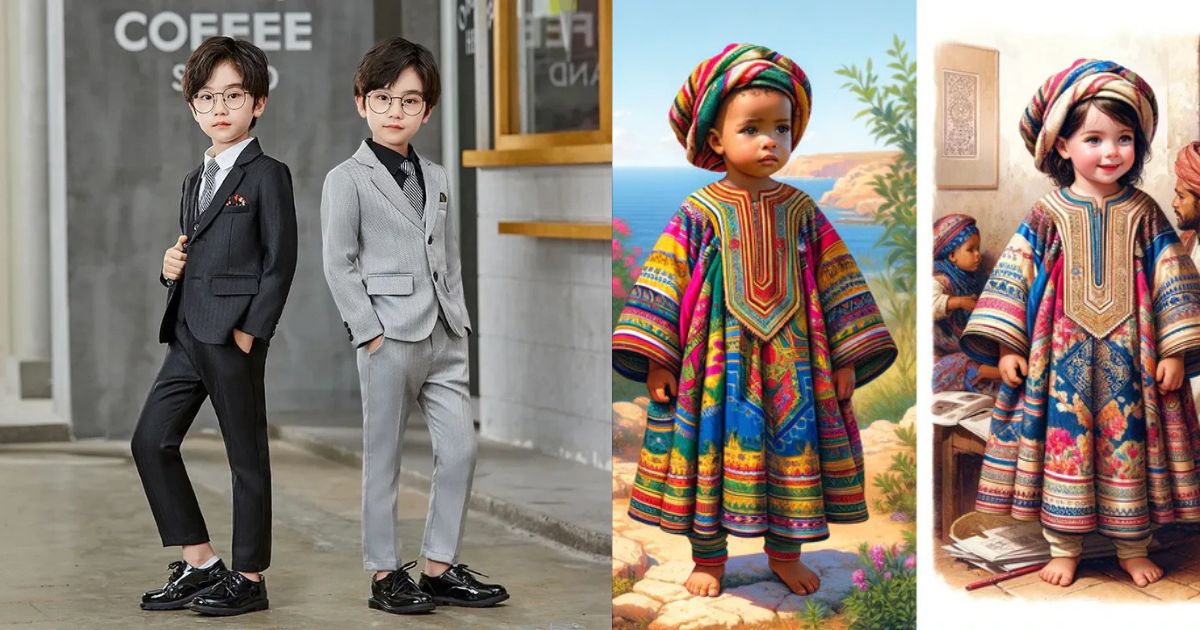Selecting children’s attire goes beyond just looking cute; it’s about comfort, durability, and adapting to their ever-changing needs. Whether for everyday wear, special occasions, or seasonal shifts, finding the right balance of style and function is key to keeping children comfortable and happy in their clothes.
Importance of Choosing the Right Children’s Attire
Children’s clothing needs to support active lifestyles and handle everything from playground scrapes to spontaneous naptime. The right clothing encourages freedom of movement and promotes confidence, allowing kids to explore and play comfortably.
Essential Factors in Choosing Children’s Attire
Comfort: Kids need clothes that allow them to move freely without restricting activity.
Durability: Sturdy materials that can withstand frequent washing and wear are ideal.
Safety: Avoiding choking hazards, such as small buttons on clothing for infants, and choosing flame-retardant materials where necessary.
Practicality: Clothes should be easy to put on and take off, especially for younger children.
Seasonal Appropriateness: Dressing children for the weather is essential for their comfort and health.
Types of Children’s Attire
Children’s clothing can be categorized by occasion, such as casual wear, sleepwear, school attire, and clothing for special events. Let’s break down each type and what to consider for each.
Everyday Casual Wear
Casual wear for kids should focus on comfort and durability. Simple t-shirts, leggings, shorts, and jeans work well. Fabrics like cotton and cotton blends are excellent for breathability and softness.
Fabrics: Cotton, jersey, and denim.
Examples: T-shirts, leggings, hoodies, shorts, and sweatpants.
Formal and Special Occasion Attire
Dressing children for weddings, holidays, or other special events means choosing pieces that look stylish while remaining comfortable.
Fabrics: Velvet, satin, tulle, or cotton blends with decorative elements.
Examples: Dresses with soft linings, button-up shirts, blazers, dress pants, and formal shoes.
School Uniforms and School Wear
School uniforms, if required, should balance formality with comfort. For non-uniform schools, focus on durable and practical items that can handle daily wear.
Fabrics: Cotton blends, poly-cotton for durability.
Examples: Polo shirts, khakis, skirts, and cardigans.
Sleepwear and Loungewear
Sleepwear should be made from breathable materials to ensure a restful night’s sleep. For young children, pajamas with footies or non-slip soles are ideal for colder months.
Fabrics: Cotton, bamboo blends, fleece for colder weather.
Examples: Pajama sets, nightgowns, footed onesies, and robes.
Seasonal Attire: Winter and Summer Clothing
Children’s attire should vary by season to keep them comfortable and safe.
Winter: Layered outfits, coats, hats, gloves, and scarves are essentials. Look for wool or thermal materials.
Summer: Lightweight, breathable clothing such as shorts, t-shirts, and sun hats. Cotton and linen are ideal for warm weather.
Popular Trends in Children’s Fashion
Mini-Me Styles: Matching children’s attire to adult styles is popular, especially for family events or photos.
Eco-Friendly Fabrics: More parents are opting for sustainable materials like organic cotton or bamboo.
Character Themes: Clothing featuring popular children’s characters or superheroes adds fun and makes dressing up exciting for kids.
Choosing the Right Fabrics for Children’s Attire
Cotton: Soft, breathable, and gentle on the skin, making it perfect for everyday wear.
Wool: Great for winter wear as it provides insulation.
Bamboo: A newer option known for being soft, sustainable, and hypoallergenic.
Polyester Blends: Durable and easy to clean, ideal for active kids and school uniforms.
Safety Considerations in Children’s Attire
Safety is a top priority when dressing young children. Avoid clothes with loose cords, and always choose age-appropriate sizes. Clothing for infants and toddlers should be flame-retardant, and loose embellishments like buttons should be avoided for young children.
Practical Tips for Buying Children’s Attire
Look for Adjustable Waistbands: Elastic or adjustable waistbands allow clothes to fit longer as children grow.
Buy a Size Up: Kids grow fast, so sizing up can extend the wear.
Prioritize Layering Options: Especially for colder seasons, layering options like jackets, hoodies, and long-sleeve shirts are versatile.
Opt for Washable Materials: Look for fabrics that can withstand frequent washing without losing shape or softness.
Affordable Children’s Attire Options
Many parents seek affordable clothing options without compromising quality. Consider:
Thrift Stores: Often carry gently used, high-quality items at lower prices.
Online Marketplaces: Sites like eBay or Poshmark have a variety of affordable children’s clothing.
Discount Retailers: Stores like Target and Old Navy offer fashionable, budget-friendly options.
Conclusion
Children’s attire is all about balancing comfort, practicality, and style. With so many options available today, parents can find clothing that meets all their needs while keeping kids happy and well-dressed. From everyday basics to special occasion outfits, thoughtful choices in children’s clothing can make dressing your little ones a joy.
FAQs
What fabrics are best for children’s clothing?
Cotton and bamboo are ideal for breathability, while wool works well for winter warmth.
How do I ensure clothing safety for my child?
Avoid clothes with small parts, loose strings, or cords, and opt for flame-retardant fabrics for young children.
What should I consider when buying children’s winter clothing?
Look for layers, like thermal underwear, jackets, and accessories like hats and gloves.
Is it better to buy children’s clothes in a bigger size?
Yes, buying a size up allows room for growth and can help extend the clothing’s wear.
How do I clean and maintain children’s attire?
Follow fabric care instructions; washing in cold water can help preserve the color and texture.
